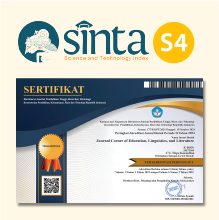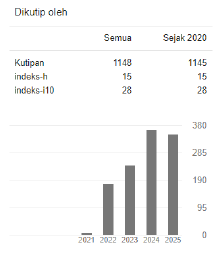Non-Observance Maxims in Banyumasan Humor Speech
 https://doi.org/10.54012/jcell.v2i3.124
https://doi.org/10.54012/jcell.v2i3.124
 Abstract views: 367
Abstract views: 367
 PDF downloads: 396
PDF downloads: 396
Keywords:
non-observance maxims, Banyumasan , humorous speech, youtubeAbstract
Humorous utterances can cause humor because listeners, readers and audiences find unexpected utterances, attitudes or things, language games and deviations in speech conveyed by a speaker or comedian due to a discrepancy between the concept and the actual situation and exaggerated and unreasonable expressions, so it can cause laughter. In a conversation, what the speaker means often goes beyond what is said. Other implied meanings can be inferred and predicted based on the context. Implicature can occur due to a violation of the principle of conversation. The violation of the cooperative principle has the aim of creating humor in the conversation. There is another basic theory of cooperative principle, namely the non-observance of the conversational maxims theory proposed by Grice (1975). It is one of the pragmatic studies in determining the implied meaning of utterances that contain humor. This study aims to analyze the non-observance maxims found in Banyumasan humorous utterances on youtube. The data collection technique in this study was to use a purposive sampling technique, namely by looking for videos that match the research object. The methods used in this research were observation, documentation and transcription. The data analysis technique in this study used descriptive qualitative data analysis techniques and was carried out through three stages according to the data analysis model of Miles and Huberman (1984), namely data reduction, data presentation and drawing conclusions. The results of the study showed that in Banyumasan humorous utterances there are several non-observance maxims, including flouting the maxims, violating the maxims and infringing the maxims. From these data, the most common is the flouting of quality maxims. This is because in humorous utterances there are non-observance of maxims that aim to create a funny impression.
Downloads
References
Abdullah. (2019). Bahasa ngapak sebagai sarana kontruksi budaya Jawa. Buletin Al-Turas Vol. 25 No. 2 November 2019, hal. 141-162.
Al-Zubeiry, H. (2020). Violation of Grice’s maxims and humorous implicatures in the Arabic comedy Madraset Al-Mushaghbeen. Journal of Language and Linguistic Studies, 16(2), 1043-1057.
Aziz, Z. A., Mustafa, F. & A’la, P. N. (2019). Flouting maxims as a sense of humor in Indonesian speech acts. Indonesian Journal of EFL and Linguistics, 4(2), 2019.
Cutting, J. (2002). Pragmatics and discource: A research book for students. New York: Routledge.
Creswell, J.W. (2008). Educational research : Planning, conducting, and evaluating quantitative and qualitative research. Boston: Pearson Education, Inc.
Grice. H.P. (1989). Studies in the way of words. Harvard: Harvard University Press.
Grice. H.P. (1975). Logic and conversation. Reprinted from syntax and semantics 3: Speech arts, Cole et al, “Logic and Conversation”, pp 41-58, 1975.
Harared, N. (2015). Non-Observance of the Maxims in Diary of a Wimpy Kid. Journal of English Language and Culture – Vol. 5 No. 1 January 2015.
Hasanah, H. (2021). Pelanggaran maksim dalam menciptakan humor: studi perbandingan antara humor Madura dan humor Jawa. Sawerigading, Vol. 27, No. 2, Desember 2021: 205—218.
Miles, M.B. & Huberman, A.M. (1984). Drawing valid meaning from qualitative data: Toward a shared craft. Educational Researcher.
Munthe, D. E. & Ambalegin. (2021). Non-observance maxims in “sonic the hedgehog” movie. Jurnal Ilmu Budaya, Volume 9, Nomor 1, Tahun 2021.
Nurdiyanto, E., & Resticka, G. (2021). Sociopragmatics competence in the characteristics of Banyumas community blakasuta. Journal of Pragmatics Research, 3(1). doi:https://doi.org/10.18326/jopr.v3i1.28-45
Oksinia, B.Y., Jayantini, I.G.A.S.R., & Sulatra, I. K. (2021). Verbal humour created by non-observance of cooperative principle in Miranda. Language Literacy: Journal of Linguistics, Literature and Language Teaching Volume 5, Number 1, pp: 80-89, June 2021. DOI: 10.30743/ll.v5i1.3582
Pawestri, A.G. (2019). Membangun identitas budaya Banyumasan melalui dialek ngapak di media sosial. Jurnal Pendidikan Bahasa dan Sastra, 19(2), 255-266. DOI: https://doi.org/10.17509/bs_jpbsp.v19i2.24790.
Rasjid, A.A., Hidayat, A., & Trianton, T. (2013). Banyumas: Fiksi & fakta sebuah kota. Solo: Beranda Budaya dan bukutujju.
Searle, J. R. (1969). Speech acts: an essay in the philosophy of language. New York: Cambridge University Press.
Searle, J. R. (1979). Expression and meaning: studies in the theory of speech acts. New York: Cambridge University Press.
Setiawati, E., & Arista, H. D. (2018). Piranti pemahaman komunikasi dalam wacana interaksional (Kajian pragmatik). Malang: UB Press.
Sugiarti, Andalas, E. S., & Setiawan, A. (2020). Desain penelitian kualitatif sastra. Malang: UMM Press.
Thomas, J. (1995). Meaning in interaction: An introduction to pragmatics. New York: Routledge.
Downloads
Published
How to Cite
Issue
Section
License
Copyright (c) 2023 Wijiasih Eka Pertiwi

This work is licensed under a Creative Commons Attribution-ShareAlike 4.0 International License.
All articles published in the Journal Corner of Education, Linguistics, and Literature are licensed under the Creative Commons Attribution-ShareAlike License (CC BY-SA).

















